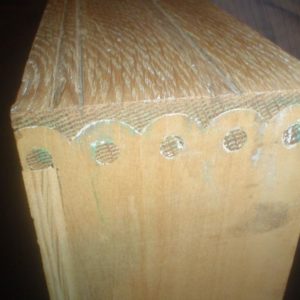Sirs I am the secretary of our local woodworking guild in Pietermaritzburg in South Africa. At the last meeting a member brought in two drawers he was restoring with the question of what was the joint between the fronts and the sides as he had not come across them before. Hopefully a photograph of the joint will appear below! The drawers were purportedly made in the mid 1800’s. The drawer fronts are oak and the round,dowel like sections are a continuation of the drawer fronts and not separate dowels. Can anyone tell us the name of this joint and how each side was formed, particularly to the sides of the drawer. Comment on a possible date on manufacture would also be appreciated.
Discussion Forum
Get It All!
UNLIMITED Membership is like taking a master class in woodworking for less than $10 a month.
Start Your Free TrialCategories
Discussion Forum
Digital Plans Library
Member exclusive! – Plans for everyone – from beginners to experts – right at your fingertips.
Highlights
-
Shape Your Skills
when you sign up for our emails
This site is protected by reCAPTCHA and the Google Privacy Policy and Terms of Service apply. -
 Shop Talk Live Podcast
Shop Talk Live Podcast -
 Our favorite articles and videos
Our favorite articles and videos -
E-Learning Courses from Fine Woodworking
-
-
 Fine Woodworking New England Event
Fine Woodworking New England Event -













Replies
It's a Knapp joint.
http://www.antiqueweb.com/articles/antique_knapp_joint_dovetail.html
Knapp's Pin and Crescent Drawer Joint
This unique machined drawer joint started the industrial revolution for furniture and replaced hand cut dovetails. It dates the furniture to a specific period. 1880 – 1900
Also known as Pin & Cove, Pin & Scallop, Half Moon, or Knapp Joint, also variously changing word “pin” to “dowel”. All these woodworking joints are basically the same, while they can vary in size.
Their presence allows dating of the furniture chest to 1880 – 1900, usually of the Victorian, Renaissance Revival or Eastlake styles. In the dating sequence of furniture construction they generally followed hand-cut dovetails. They clearly pre-dated what is called “sliding French dovetails”.
Hand made dovetailed drawers were very labor intensive and limited mass production of chests. The Knapp Joint is the first known mechanization for making drawers in the industrial revolution age.
The inventor was Charles B Knapp of Waterloo, Wisconsin with a patent dated 1867. There was by 1871 a Knapp Dovetailing Company of Northampton, Mass. The joint concept fell into lack of use by 1900.
We have separately read, but can’t now document, that the dating was about the same but that the concept of the joint was French and the window of use was only for 12 years. Who knows?
View Image View Image
References include:
Pictures by The Wood Works Inc. Essay “Mr. Knapp’s Oddity” by Fred Taylor, the origin of which is not known. And The Knapp Joint by Arnold Silverman of the Colorado Period Furniture Makers Guild.
http://vintagemachinery.org/mfgindex/imagedetail.aspx?id=3750
To learn more about this topic or The Wood Works, Inc., our products and how our services and expertise can help you, give us a call or visit our showroom.
See "before-and-after" samples in our showroom as well as our website!
Showroom open Mon – Fri. 8 a.m. – 4 p.m.
http://www.thewoodworksinc.com
10059 Hemlock Drive, Overland Park, KS 66212
Call 913-362-2432
FAX 913-362-0588
Tuesday, May 4, 2010
The Knapp Joint
One way of telling the age and place of manufacture of a piece of furniture is to look at the way that the drawers are constructed. The dovetail joinery on the sides where the front of the drawer meets the sides can tell you a lot. for instance, if the piece was made in the U.S. or England. Also a hand cut dovetail usually points towards an older piece. Most modern joinery is done with a machine.
Creating a machine to cut those joints was not an easy task. During the 19th century, as furniture production became more and more mechanised, furniture companies tried frantically to create a machine that would cut dovetail joinery with limited success.
One of the people working on this was Charles B. Knapp of Waterloo, Wisconsin. What Mr. Knapp did was to question the form of the dovetail and opted for an entirely new design. Called the Knapp joint, the joint consists of integral dowels and half round mortises in the face of the drawer and a half-round "tail" with a hole drilled out to receive the dowel on the drawer sides. Below is a photo of this joint:View ImageMr. Knapp completed the joint making machine in 1867. In 1870, he sold the rights to some investors who sold the machine under the name "Knapp Dovetailing Company" located in Northampton, Mass. By 1871, Furniture companies on the east coast primarily were using this machine to further speed the production of case furniture. Nearer to the turn of the century, the furniture this was used on was cheaper and by 1900, the machined dovetail was in use. This information gives a very specific window of time when dating Victorian furniture. Most Eastlake period case pieces will have this style of joinery. I will say this, I find that if I need to disassemble a drawer made from this joint, it does a pretty good job of staying together!
This forum post is now archived. Commenting has been disabled